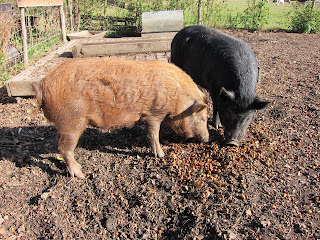Sasso Hen
The weather continues to be extremely mild and I worked all day wearing a T-shirt, despite a gentle drizzle which drifted diagonally throughout the afternoon. Having said that, if it had been -4°C, I doubt that I would have been particularly cold, as hauling brash is strenuous work. As well as the physical exertion there was also the raging fire which inevitably I gazed at with primeval fascination after throwing on every load, feeling the familiar sensation of fierce heat drying out my lips and skin. A brash fire is unlike any other, it is dynamic and ever in need of attention. With a log fire of seasoned wood the kindling is lit, larger logs added and away it goes but to have a successful blaze of bushy living stems, an element of artistry is required. Firstly a good fire of dead wood must be made to the size of a decent campfire, then every piece of brash cut into short lengths and stacked high directly on top. The constant battle is to prevent the centre burning out and with trees such as Hawthorn this can happen easily when pieces that are too large are added initially. If the starter fire was sufficiently strong a tongue of flame will slowly weave up through the thatch, crackling ferociously. At this point there is always the temptation to throw anything of any size on but repeated experience has shown me that it's worth persevering with short lengths placed meticulously on top until the whole structure is a mass of flames. Only then can loading start in earnest and if each addition, still placed right on top, is engulfed then the time has arrived to work hell for leather feeding the insatiable crimson cone rearing into the air. Religiously adding the stems in the same direction helps to create an orderly stack and that should always be the aim. Even an apparently established fire can burn out in the middle if the brash does not form a neat column above which moves down under its own weight as the material below is consumed. When going properly, a fire of this sort burns with a formidable, smokeless heat, popping the bark from living stems and turning them to curling cinders in seconds. My father taught me these things over 20 years ago and I have never forgotten them nor lost my fascination for that wild flame which has cost me so many eye brows and lashes.
Later in the afternoon Em (and G of course) dropped round with friends and leaving the heap of glowing charcoal I joined them to walk down into the valley. Below us the dark green bramley orchard was divided by lines of bright yellow Worcester
Dinner
Roast chicken with red cabbage casserole, roasted vegetables, sprouts and bread sauce. This was our first sampling of a ‘Sasso’ a French free range meat variety which we are rearing for the first time. There was ample flesh, more than on our usual crossbreds, but to me at least, it was dryer and not so tasty.




















